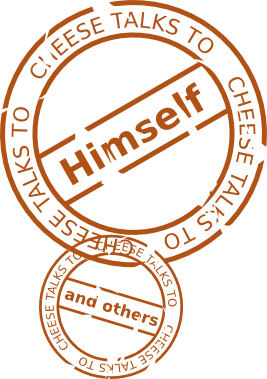
This article was written to explore what statistics gathered from the Humble Indie Bundle promotions might indicate. Unlike the Humble Visualisations (a collection of additional statistics and graphs derived from those shown on the Humble Bundle website), this article contains information drawn from non-official sources as well as some Blatant Opinions.
In addition to my own thoughts, I've also gathered some quotes and anecdotes from top Humble Bundle contributors. Whilst their opinions may not represent the bulk of Humble Bundle purchasers (or myself for that matter), I do believe that they as individuals represent a significant amount of inspiration to others and have helped the Humble Bundle promotions grow and thrive.
Stuff we're going to talk about:
- A Humble What-What?
- What Statistics Aren't
- The Changing Shape of Bundles
- General Trends And Anomalies
- Platform Trends And Anomalies
- Impact On Gamers And Developers
- Closing Thoughts
- A Humble Update
Portions of this article are fairly dry. With that in mind, I've tried to divide it up into sections that can be read independently, with the exciting stuff at the beginning and end. The charts and quotes are styled in a way that should make them stand out, so if that's what you're interested in, feel free to scroll through and read only those.
A Humble What-What?
Just in case anybody who hasn't heard of the Humble Bundle promotions manages to stumble across this page, let's have a quick recap. The Humble Indie Bundle is best summarised in grammatically flowing dot points, like so:
- For a limited time, you can
- Pay what you want for
- A selection of awesome indie games available on
- Linux, MacOS and Windows
- DRM free, with
- Proceeds divided between developers and charities in whatever distribution you desire
The Humble Bundle promotions have been running since May 2010, and at the time of writing have raised nearly $13 million that has been distributed between charities and independent game developers.
In addition to raising money and bundling up games, the Humble Bundles have helped launch source code for over 15 projects and challenged some preconceptions about how gamers and the game development industry works.
"My main reason for donating was initially to help promote indie games, but it quickly became a way for me to give to charity in a fun way. The bidding wars with Garry Newman and now lately with the bronies very much shows how well something like this could be used as a fundraiser. I personally tend to set all money towards charity because I usually own all the games on the list, and I just want to help promote the great games on there combined with giving to charity." - @notch
The charities that Humble Bundle contributors have supported have been the Electronic Frontier Foundation (a not-for-profit that lobbies for, raises public awareness of civil liberties and digital rights), Child's Play (a charity that provides games, toys and books to children in hospitals around the world), the American Red Cross (a charity that provides emergency assistance, disaster relief and education within the United States of America), and charity: water (a not-for-profit organisation that facilitates the development of clean and safe drinking water infrastructure in developing nations).
↑return to top↑What Statistics Aren't
The thing about the Humble Bundle promotions is that they make people passionate. Really passionate. Whether you're a philanthropist that's excited by the charities, a gamer who's excited by independent games, a developer who's cranky about the way the industry treats them, a commentator who cares about platform equality, a platform evangelist who's tired of feeling ignored, a Humble Bundle fan who's anxious about the frequency of promotions, or even someone who's excited about My Little Pony, it's hard to not get carried away.
For many of these people, there is something at stake or something to prove, and though that sounds irrelevant, it does provide a lot of the motivation for purchasing and supporting the bundles, so it's worth acknowledging. Passionate people tend to see statistics as validation of their opinions, so before we move on, let's quickly address some things:
- Statistics can't tell the future
- Statistics can't tell the present
- Statistics can suggest stuff about the past that allow us to guess about the future
"The bidding war with Notch was just me being cheeky more than anything else. I thought it would be funny - I didn't think it'd get as much attention as it did. If it got them more attention and got the charity's more money I'm happy - but if I'm honest that wasn't my intention - I'm not that smart :)" - @garrynewman
Why bother with them if they can't give us anything solid? Well, like Drake's Equation, the real purpose of all these graphs and numbers is that they encourage us to explore possibility space and broaden what we're capable of understanding, anticipating and reacting to. By extrapolating trends and making educated guesses, we can focus our attention on areas that have more chances of favourable outcomes.
↑return to top↑The Changing Shape of Bundles
Bundle Styles
Over the past 22 months and 10 promotions, the Humble Bundles have come in three different flavours: the "Humble Indie Bundles", bundles focused around a single game or developer and a "game jam" event.
Typically, the Humble Indie Bundles (which I'm going to be referring to as "Indie Bundles") consist of 5 core games spread across a range of genres from a variety of independent game developers. During the promotions, bonus games are often added, providing additional incentive. These bonuses usually include games from previous Indie Bundles. To date, there have been 4 Humble Indie Bundles.
The second type of bundle seen (which we'll call "Non-Indie Bundles") is generally centred around one or more games from a single developer. As the bulk/focus of content is from a single source, the variety of games on offer tends to be narrower. Like the Indie Bundles, these bundles are often supported by bonus games added during the course of promotion. To date, there have been 5 Non-Indie Bundles.
The final and most recent type of promotion is a "game jam" event, where developers attempt to create a game from scratch within a specified time period. To date, there has been one single Game Jam Bundle titled the Humble Bundle Mojam, and in the interests of graph and charts with a single sample, it will be categorised as a Non-Indie Bundle for the rest of this article. Unlike the Indie and Non-Indie Bundles, which typically run for 14 days, the Mojam ran for 60 hours. In addition to the initial developers, two additional development teams joined in after the promotion started attempted to create their own games from scratch within the time remaining.
Game Count
With the exception of the Indie Bundles, the number of core games varies from bundle to bundle. Bonus game numbers tend to fluctuate as well.
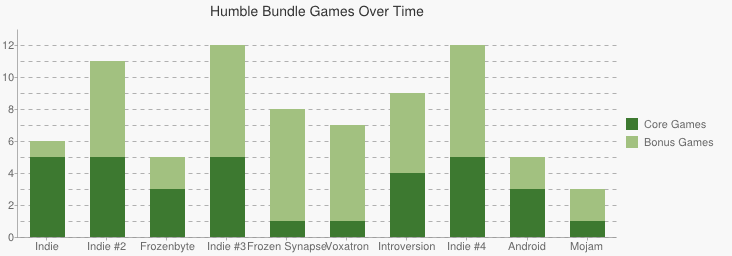
For the purposes of the above chart, any game that was not a part of a bundle at the time it commenced is considered to be a bonus game. Splot and Jack Claw from the Frozenbyte Bundle are also listed as bonuses as they were described that way when the bundle launched.
If you're looking for a complete list of titles included in Humble Bundle promotions, there's a decent list on the Humble Bundle Wikipedia page.
Bonuses
Bonus games are added to bundles in one of two ways. Single games may be added as free bonuses to all existing and future purchasers of the bundle, or they may be made available to existing purchasers and any future ones who contribute more than the cross-platform average. When groups of games are added, they have required payment above the average for future purchasers.
Excluding the first, every Indie Bundle has included the previous Indie Bundle as a bonus. Though this does detract from the limited-time aspect of the promotions, it has impacted positively on individual bundle sales. Of the Non-Indie Bundles to date, only the Frozen Synapse bundle has included a previous bundle.
The Mojam, Introversion and Frozenbyte Bundles have included bonus games that are not compatible with all three operating systems (Jack Claw, City Generator Tech Demo, Voxel Tech Demo, Fists of Resistance). Jack Claw was subsequently ported to Linux and MacOS.
Every bundle excluding the Mojam Bundle has included soundtracks for one or more games. The Frozenbyte Bundle included a soundtrack sample for Trine 2, a game not included in the bundle.
Alphas/Unfinished Games And Tech Demos
Several bundles have included or featured playable incomplete games (in what is often called an "alpha" state) with the promise that updates will be made available as game progresses towards completion. Of these, Cortex Command and Voxatron have been core games, with Voxatron being the only core game in the Humble Voxatron Debut.
The Introversion bundle also included two "tech demos", a procedural city generator and a voxel system simulator created for Introversion's cancelled/suspended title Subversion.
Bundle Frequency
Over time, the frequency with which Humble Bundle promotions occur has increased dramatically.

The red points indicate a Humble Indie Bundle, while the blue points represent non-Indie branded bundles. Please note that though the points on the timeline are placed according to actual data, the tickmarks representing the beginning of a month are indicative only.
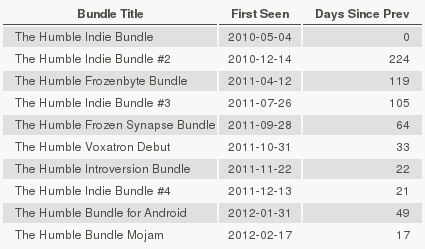
"They do seem to be coming around a bit too often nowadays. I don't know whether that's a good thing or whether they'd be better serving people if they do one every 6 months with 60 games, rather than one every month with 10 games. It seems obvious that they make more money if they do one a month - but I dunno, it seems against the spirit of it. It's less special if it's happening all the time, like if it was Christmas every weekend." - @garrynewman
Source Releases
Many of the bundles have been accompanied by source code releases. These have included entire games, game engines and utility libraries. The licencing for source releases has been decided by individual developers, leading to a variety of licences with varying degrees of "freeness".
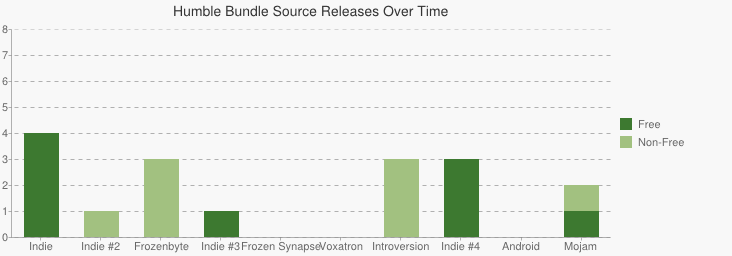
Licences listed as "free" fall under the GNU definition of a Free Software Licence. Though the source code for The Broadside Express is public domain, the source release itself contains assets with additional "non-free" licences.
Below is a list of source releases along with their licences and links to related news posts or project pages:
- Aquaria (GPL)
- Gish (GPL)
- Lugaru HD (GPL)
- Penumbra (GPL)
- Revenge of the Titans (Puppygames licence)
- Shadowgrounds (non-commercial Frozenbyte licence)
- Shadowgrounds Survivor (non-commercial Frozenbyte licence)
- Jack Claw (non-commercial Frozenbyte licence)
- Haaf's Game Engine - Unix (used by Hammerfight) (zlib licence)
- Darwinia/Multiwinia (requires-original-game Introversion licence)
- Uplink (requires-original-game Introversion licence)
- Defcon (requires-original-game Introversion licence)
- MojoShader enhancements (zlib licence)
- TheoraPlay (zlib licence)
- MojoDDS (zlib licence)
- Catacomb Snatch (no licence)
- The Broadside Express (public domain, CC-BY-NC and GCTextures licences)
Distribution
The primary distribution method for Humble Bundle promotions is via the humblebundle.com website's key based download pages, where DRM-free versions of the games for each platform, soundtracks and source (where applicable) can be downloaded.
Following feedback from an anonymous survey on the causes of Humble Bundle piracy conducted via the Humble Bundle Twitter account, BitTorrent download options were added from the Humble Indie Bundle #2 onwards.
Every bundle excluding the Mojam Bundle has come with Steam redemption keys for some or all of the games (excluding unreleased/alpha games and tech demos), allowing these games to be added to a Steam account and the Windows and MacOS (where available) versions to be downloaded and automatically updated.
Every bundle inclusively between the Humble Indie Bundle 2 and the Frozen Synapse bundle included Desura redemption keys for some or all games (also excluding unreleased/alpha games and tech demos), allowing these games to be added to a Desura account and the Windows and Linux (where availabe) versions to be downloaded and automatically updated. In addition, Desura keys for Blocks That Matter from the Humble Voxatron Debut were made available to purchasers who requested them (on a side note, by forwarding Desura's tweets offering to help make keys available to Swing Swing Submarine, who at the time hadn't seen it, I may have been instrumental in making this happen). In December 2011, during the Humble Indie Bundle #4 promotion, the Desura announced via Twitter that they were working towards making Desura keys for Humble Bundle games available, but at the time of writing, no keys have been made available for either that bundle or ones that have followed.
Onlive redemption keys were included for Trine, Braid and Osmos in bundles that included them.
According to Wikipedia, Direct 2 Drive keys were apparently made available with the Frozen Synapse Bundle, but the Direct 2 Drive key button no longer appears on the Frozen Synapse Bundle download pages.
For the Humble Bundle For Android promotion, an alpha of an Android based downloader app was made available to assist Android users with managing and updating their Humble Bundle games.
Charities
Until the Humble Indie Bundle #4, all promotions offered Child's Play and the Electronic Frontier Foundation (EFF) as charities towards which contributions could be donated. For the Humble Indie Bundle #4, the EFF was replaced by the American Red Cross as voted on by the developers of the games included in the bundle. The Humble Mojam Bundle is unique in that it had four charity options: Child's Play, the EFF, the American Red Cross, and newcomer charity: water.
↑return to top↑General Trends And Anomalies
Cross-Platform Purchases
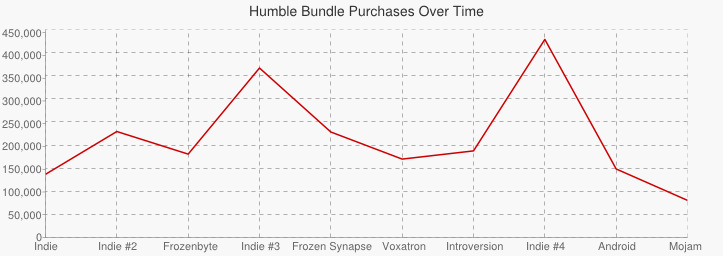
Examining the fluctuations in purchases across each promotion, we can see obvious peaks standing out for every Indie Bundle with progressively larger drop-offs. The Introversion Bundle stands out as the only Non-Indie bundle that has had a higher number of purchases than its predecessor.
The sharp downward trends following Indie Bundles suggest that the Non-Indie Bundles have narrower appeal, with the Indie Bundles' broader variety of gameplay options being one of the most likely contributors. The post-Indie Bundle dips become steeper as time progresses, suggesting that the number of recurring customers may be dropping. This could be the result of buyer fatigue, or reduced disposable income available as the time between bundles tightens.
"Unfortunately, it's become expected of me to go crazy in the humble indie bundle, so it's starting to lose its novelty... so I was really happy to see the bronies go all in with a crazy impressive sum." - @notch
The Introversion Bundle's performance may be the result of a combination of a broader selection of core games than the preceding two Non-Indie Bundles, the quality of titles included, and the support of Introversion's existing fan base and the odd celebrity.
Looking at the Indie Bundles alone, the steady climb as time progresses seems to suggest increasing awareness and market penetration as the Humble Bundle promotions become more established and defined. The Non-Indie Bundles show a bumpier road, with a strong start with the Humble Frozebyte Bundle and the purchase figures peaking at the Frozen Synapse Bundle, only to dip for the Voxatron Debut and climb again for the Introversion Bundle before dropping away for the Android and Mojam Bundles.
The alpha-status of Voxatron and The Binding of Isaac's mature themes may have made some potential contributors wary, and the smaller range of titles in the Android Bundle may have contributed to the lower sales. One other aspect of the Android Bundle that could have led to lower purchaser numbers is confusion around the title leading to the impression that the games in the promotion were only available for Android devices. The Mojam Bundle's short running time plus the uncertainty of quality and readiness of the in-progress games are likely to have limited that Bundle's appeal beyond those specifically interested in indie game development.
The performance of the Frozen Synapse bundle can be partially attributed to Frozen Synapse and Space Chem's relatively recent launch dates and high existing popularity. That the Frozen Synapse Bundle also came with the Frozenbyte Bundle games is likely to also have had an impact.
Cross-Platform Revenue
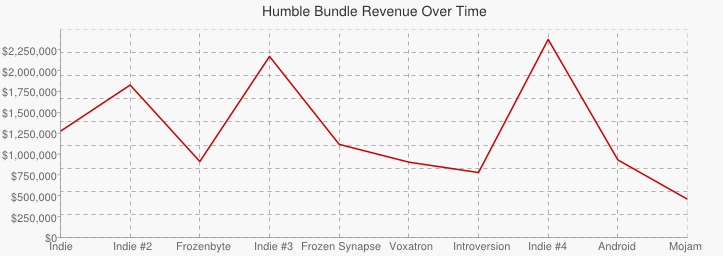
Moving on to revenue, we can see drop-offs immediately following the Indie Bundles that correspond with those shown in the purchases graph. Each post-Indie Bundle dip represents a drop of at least $1 million, which seems to support the notion that the Non-Indie Bundles are of less value to potential Humble Bundle customers, or that Humble Indie Bundle purchasers have used up the majority of their game bugdets by the time the Non-Indie Bundles appear.
The steady climb for the Indie Bundles matches the growth in the purchases graph, suggesting again that increased awareness and broader sales have expanded the contributor base. Looking at the Non-Indie Bundles, we can see a peak at the Frozen Synapse Bundle, followed by a downward trend towards the Introversion Bundle before climbing to the Android Bundle and finally falling off for the Mojam Bundle.
To me as a content producer, I'd rather have a million people paying a dollar rather than a hundred thousand people paying 10. With the pay what you want model, you have the potential to not just make money, but even if you make less or the same amount of money, you reach a broader audience." - @tpjeff
The complementing variances seen in the averages graph below suggest that the individuals not buying Non-Indie Bundles are consistently contributing below average amounts for the Indie Bundles. Possible contributing factors to the Mojam Bundle's anomalous low are its short timeframe combined with the long lead time before a playable build was made available, lower cross-platform support, and the first playable build of Fists of Resistance being released after the promotion had expired.
Cross-Platform Averages
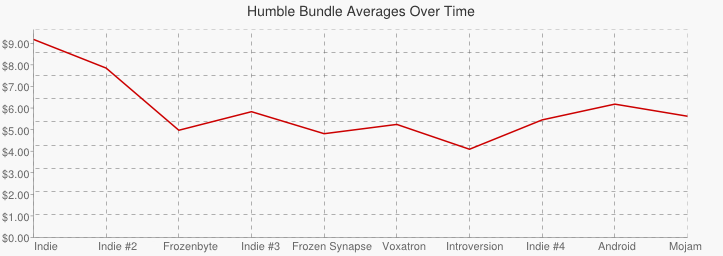
The averages graph shows a fairly clear downward overall trend, with particularly low dips evident at the Frozenbyte Bundle, Frozen Synapse Bundle and Introversion Bundle. The Indie Bundles show typically higher averages, while the Android Bundle and Mojam Bundle have the strongest cross-platform average of any Non-Indie Bundles.
It is interesting to note that the Frozenbyte bundle was the first Non-Indie Bundle, the Frozen Synapse Bundle was the first single-game promotion, and the Introversion Bundle was the first bundle to include non-game tech demos as bonuses, all of which could have had a negative effect on the perceived value of each bundle.
Based on the individual platform purchase graph below, the increased average of the Android Bundle is likely to be directly linked to significant decreases in Windows and MacOS purchasers, allowing the higher Linux average payment to stand out in the cross-platform averages. Other contributing factors could be the existing popularity of Two Tribes' games, the high level of polish in Anomaly: Warzone Earth, and differences in perceived value of games between PC (in the "personal computer" sense) and mobile platforms.
The Mojam Bundle's higher average is likely to be attributable to a shift in demographics, with the event being more accessible to people specifically interested in game development. All 10 "top contributors" have contributions of over $1,000, a feat otherwise only seen in the Humble Indie Bundle #2.
Focusing on Indie Bundles, we can see a consistent downward trend that suggests broader market penetration is reaching more purchasers who are paying less. Though this sounds negative, this is the crux of the pay-what-you-want model: making offerings available to customers who would not be interested in a fixed price point alternative. These lower paying contributors may be bringing the averages down, but looking at the cross-platform revenue graph above, it is clear that these extra contributors combined are responsible for bringing significant boosts to the total revenue figures.
"One of the things I love about this model so much. Everyone contributes at their own level. I love that someone who is almost totally broke can still get ahold of it and relatively speaking can put in as much as notch is." - @tpjeff
Looking at the Non-Indie bundles, we see a rising trend with a significant dip at the Introversion bundle, and a slight fade away at the Mojam Bundle. With the celebrity tweet mentioned earlier, it's possible that the Introversion Bundle was exposed to new audiences who were not interested in paying above the average. The individual platform averages for the Introversion Bundle reveal MacOS and Windows both having significant drops while the Linux average rose marginally.
As mentioned above, the different format and deliverables of the Mojam Bundle are most likely responsible for the slight drop in average.
↑return to top↑Platform Trends And Anomalies
Platform Purchases

The first thing that is immediately obvious when comparing platform purchase numbers is the domination of Windows. With the exception of the first two Indie Bundles and the Android Bundle, Windows purchasers have accounted for well over three quarters of each promotion's buyers. Typically, the relationship between Linux and MacOS purchasers shows higher numbers of MacOS buyers, with Linux purchases equal to roughly 60% of MacOS purchases. The major exception to this is the Android Bundle, for which Linux purchasers amounted to nearly double their MacOS counterparts.
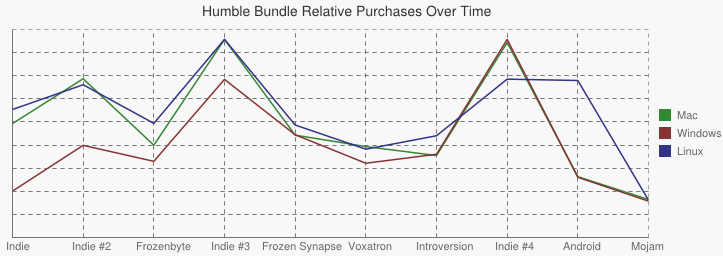
The data sets shown on this graph are not to scale. The data has been resized so that each set's peaks are of a comparative height to highlight relative variations. If you want to see graphs that directly compare platform purchases, see the Humble Visualisations
Looking at the proportional variations between platforms, Linux, MacOS and Windows all seem to be subject to similar peaks and troughs. The similar variations suggest that all three markets are subject to similar pressures and are likely to be comprised of similar demographics.
The lower interest in the Frozenbyte Bundle from MacOS purchasers may be due to the Frozenbyte Bundle's status as the first Non-Indie Bundle. The change in style and tone of the bundle may have appealed to people who specifically enjoyed the types of games found in the first two bundles. It is also possible that the Windows-only Jack Claw prototype may also have been off putting. Similarly, the poor MacOS response to the Introversion Bundle's poor response may be linked to the two Windows-only tech demos.
The proportionally large Linux response for the Android bundle is most likely due to an overlap of Android and Linux users, whilst Windows and MacOS users are more likely to be using non-Android mobile platforms, making the bundle only accessible for the PC versions of the games.
"The price difference between Windows and Linux I'd personally put down to short man syndrome. This isn't a bad thing for anyone really, and it's obviously invited by the Bundle showing the stats per platform on the site (same with the top 10 contributors). If they showed the average contributions per gender/race/sexuality/eye colour you'd likely see the minority in those categories contributing the most too." - @garrynewman
The Linux proportionally lacklustre purchases for the Indie Bundle #4 coincide with a charity change that saw the removal of the EFF, whose focus on freedom, privacy and consumer rights overlaps well with many Free Software community ideologies. The Humble Indie Bundle #4 was also the first Indie Bundle to not include Desura keys since the first Humble Indie Bundle promotion. With the Desura Linux client out of beta and starting to be broadly used by Linux gaming communities, the lack of Desura keys incited some individuals to leave comments on the Wolfire blog, and Desura profiles saying that they will be paying less for or even boycotting Humble Bundle promotions that ship without Desura keys.
It is also possible that Linux purchase numbers may appear proportionally lower due to inflated MacOS and Windows purchase numbers from individuals abusing Steam keys during the Steam Winter Sale, but I find it unlikely that those people would have bothered to set their preferred operating system when retrieving their Steam keys.
The Humble Bundle Mojam received the lowest number of Linux purchases for any bundle to date. The primary causes for this are likely to be the comparative lack of native Linux support combined with the delay before playable builds were available and the mere 17 day lead time since the previous bundle.
Of the combined purchases for all Humble Bundle promotions, Windows accounts for roughly 75%, with MacOS around 13%.
Platform Revenue
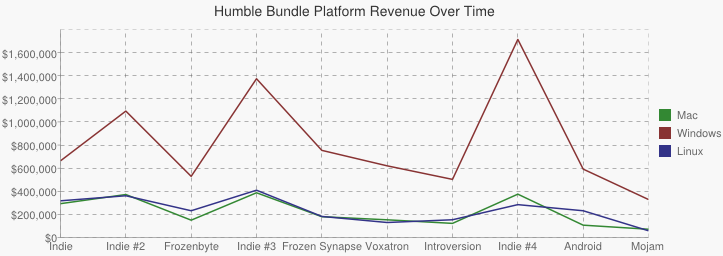
As with the purchases comparison graph, it is clear to see in the revenue comparison graph that the platform responsible for largest amount of revenue is Windows, though higher averages give Linux and MacOS more presence than can be see in any of the purchaser statistics.
MacOS and Linux revenue stays roughly equal throughout the most of the promotions. Noticeable standouts include the Frozenbyte Bundle, which received more Linux revenue, Indie Bundle #4, which received less Linux revenue, and the Android Bundle, which received more Linux revenue.
Several factors may have contributed to the Frozenbyte Bundle encouraging larger contributions from Linux users compared to other bundles. As one of the early promotions, the Frozenbyte Bundle occurred before the average payments had dropped significantly. The Frozenbyte Bundle also had more 3D titles than any previous bundle, each with scope and tone that hadn't been seen before in a Humble Bundle promotion. Though the licences are not Free Software friendly, the Frozenbyte Bundle also had more source releases than the previous promotions.
"Both Mark and Mt.Gox love the indie world, whether it could be within the game industry, music, cinema... And what we did for Frozenbyte Bundle we will surely do it again in the future." - @mtgox
The lower Linux revenue for the Indie Bundle #4 promotion seem to be a combination of both fewer Linux purchases and lower Linux averages. As mentioned above, the EFF not being included as a charity and the lack of Desura keys are likely to be the biggest contributing factor. The suggested overlap between Linux users and Android users also mentioned above is supported by the revenue breakdown.
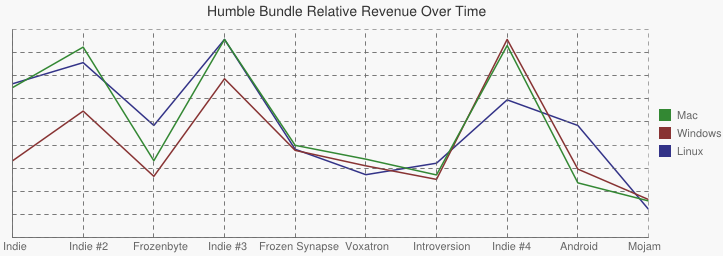
The data sets shown on this graph are not to scale. The data has been resized so that each set's peaks are of a comparative height to highlight relative variations. If you want to see graphs that directly compare platform revenue, see the Humble Visualisations
The comparison of proportional revenue fluctuation shows again that for the most part, all three platforms behave similarly in response to each promotion.
The proportionally lower Linux revenue at Indie Bundle #2 seems to correspond with a smaller climb in purchase numbers compared to other platforms, as is the proportional drop in revenue from MacOS at the Frozenbyte Bundle.
The proportional increase in revenue from Linux at the Introversion Bundle is in part caused by the high average of Linux payments combined with lower average payments and purchase numbers from other platforms. As mentioned above, the proportional drop in revenue from Linux users at Indie Bundle #4 is likely to be caused by a number of contributing factors, and the Android Bundle's proportionally less pronounced dip is touched on above as well.
The Humble Bundle Mojam event's proportionally low revenue from Linux users is directly caused by the reduced number of Linux contributors to that promotion.
"So for me it all comes down to the feeling of being part of something new and exciting. A feeling you dont really get from other charities, sadly." - @tantepose
Windows accounts for roughly 64% of the total revenue across all promotions. MacOS and Linux each represent about 17%, with Linux revenue marginally higher.
Platform Averages
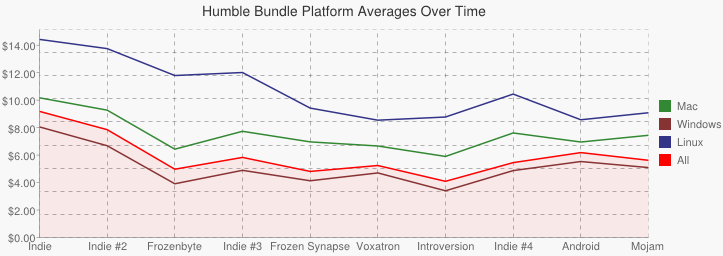
Looking at the platform averages graph, the three platforms are consistently ranked Linux, MacOS and Windows, with Linux users contributing the highest average amounts on average, and Windows users consistently contributing averages below the cross-platform average. Whilst the Linux average has remained on top for every promotion, it has also dropped the most. In spite of this, the Linux average has maintained a value at least as high as the highest MacOS averages bar the first Humble Indie Bundle.
The average payment figures seem to suggest that Linux users are more willing to spend money on games. With the Linux platform comparatively unrecognised as a game platform next to Windows and MacOS, many Linux users may be contributing extra to prove that Linux markets are viable. Another possibility could be that with fewer native titles to choose from, money that might have been used to buy other titles is helping to drive averages up. It is also likely the pay-what-you-want model, charity support and source releases specifically resound with Linux users.
With the range of other titles and deals currently available for Windows, it is possible that many Windows users may choose to allocate their funds more sparingly to Humble Bundle promotions. There have also been reports of individuals engaging in Steam key harvesting, "scalping" and other purchase abuse methods that may bring down the average for personal gain.
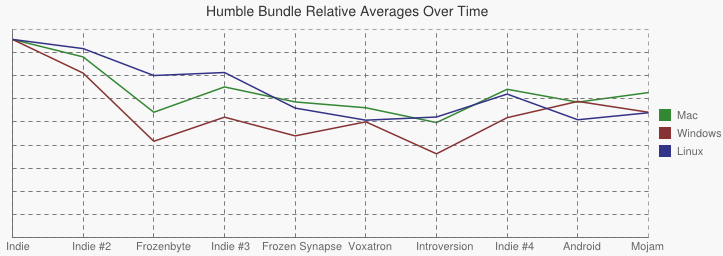
The data sets shown on this graph are not to scale. The data has been resized so that each set's peaks are of a comparative height to highlight relative variations. If you want to see graphs that directly compare platform averages, see the Humble Visualisations
The proportional comparison of averages graph illustrates that the Linux average, though downward trending, is less susceptible to individual bundle fluctuations. The Linux average seems less likely to climb for Non-Indie bundles compared to other platforms. MacOS averages proportionally mirror Windows averages, with the exception of a proportional dip at the Android Bundle.
The comparatively low MacOS average for the Android is most likely caused by MacOS users being more likely to own non-Android mobile divices. Possible causes for the proportionally high Linux average at the Frozenbyte Bundle has been discussed above. The proportionally low Linux Average for the Voxatron Debut may be the result of a lack of preceding source releases, being the first Non-Indie Bundle to immediately follow after another, or being the first bundle to feature a single game in an alpha state. As mentioned above, the Introversion Bundle appears to have encouraged a positive response from Linux gamers. Introversion have specifically commented on the positive reception they have received from and relationship they have with Linux users. The proportional dip for Windows at the Mojam bundle seems to be an indication of how much Windows users are willing to pay for games created during a game jam.
"Indie games, in general, are an amazing phenomenon. We're seeing awesome stuff coming out of tiny studios with little funding, pushing the art forward in ways a lot of big studios don't want to risk. So that, too, is something worth showing my support for. Some people seem to believe the bundles are cheapening indie games as a whole. It's certainly raising awareness, though." - @expiredpopsicle
The cross platform average payment across all bundles to date is $5.82, $10.99 for Linux, $7.73 for MacOS, and $4.96 for Windows.
↑return to top↑Impact On Gamers And Developers
Indie Game Development/Distribution
One of the key things to come out of the Humble Bundle promotions has been the proliferation and encouragement of Linux ports of independent games. In turn, this has started to challenge some preconceptions on the side of software creators that stand in the way of platform equality.
Following the success for the early Humble Bundles, numerous similar bundle promotions have appeared. It is interesting to note the characteristics these younger bundles share with the Humble Bundles, and which ones they don't. For example, The Indie Gala maintains the pay-what-you-want model and allows customisable contribution amounts to go to charity, but they have no cross-platform focus. The Indie Bundle have a DRM-free stance, but have set prices for their promotions. IndieRoyale combines the beat-the-average aspect with the pay-what-you-want model to create a competitive pay-at-least-the-average style of customisable payment, but there are no charities involved.
The rocket like success of the Humble Bundle promotions can become a double edged sword. I've spoken with several developers who are under the impression that pay-what-you-want bundles are an instant ticket to fame and fortune, rather than a strategic trade of calculable revenue for additional customers. Having a game in a successful bundle can also significantly erode the market for that game, driving down demand and making the exposure and goodwill generated for a developer potentially useless unless they have additional offerings to build a direct developer to gamer relationship.
"I gave to the Humble Mojam because I really like the idea of game developers being involved in charity, and I wanted to support that." - @NimbleDave
It's also been interesting to see the way in which independent developers are actively supporting the Humble Bundle promotions. Whilst I'm sure there is a degree of self-promotion at work, all of the people who have contributed quotes and anecdotes to this article seem very genuine and are specifically interested and invested in supporting the bundles and the exploration of promoting and publishing independent games that it represents.
Indie Gamers
The most obvious positive aspect of the Humble Bundle promotions is the highlighting of great independently developed games and making them accessible not only by allowing gamers to set their own prices, but also by distributing the games DRM-free across the three major desktop operating systems, giving gamers the freedom to play what they want, how they want, when they want.
The bundles also empower gamers to feel like they can make a difference. By allocating their contribution to developers and charities, gamers have the opportunity to make a grounded social contribution to culture (in the case of game developers) and society (in the case of charities) while celebrating their love of games. That's something that's not very common, and in a world where games are often seen as a negative influence, this sort of thing has the potential to change lives and perceptions.
"What motivated me was the chance to support something more than just classic charity. The chance to support a project; a movement of sorts. The chance to support the revelation of games and gamers as something more than just games and gamers. Two words that are too often associated by the general public with negativity, even in 2012. There is something ironic with the whole "war-games saving children from war"-thought. As well as the "pay as much as you want for DRM-free material that very easily could be yours for free"." - @tantepose
By allowing gamers to set their own price according to the value they place in a bundle, the Humble Bundles promotions are fostering a sense of ownership. Watching the buzz as a bundle reaches a milestone or the excitement as the count down clock ticks its final minutes, it's not hard to see that beyond being a clever way to get a few games, the Humble Bundles are events that bring people together.
↑return to top↑Closing Thoughts (Wild Postulation)
Looking across the information and speculation I've brought together here, there are a number of broader interpretations that stand out to me.
The first is that the comparative expansion of Windows contributors versus MacOS and Linux. It seems fairly clear to me that the Humble Bundle promotions are only just beginning to gather mainstream awareness amongst Windows users, and this will continue to expand with each Indie Bundle, coinciding with further drops in averages as more less-passionate individuals start contributing (I think it's fairly safe to say at this point in time that every person who is specifically excited about independent game development and/or playing indie games is already onboard, and that generally speaking, they're going to pay more than those who aren't).
MacOS and Linux on the other hand seem to be much closer to their respective saturation points. As time goes on, I think we'll see averages continue to slowly drop until they reach a sustainable threshold somewhere around the $8 - $12 mark, with punctuations for specifically attractive games. One interesting thing is that by making cross-platform titles available, the Humble Bundle promotions are (in part) enabling gamers to feel more comfortable moving between platforms. By knowing that their library of indie games will continue to work, some Windows users may feel more comfortable migrating to Linux, or some Linux users might feel better about moving to MacOS. This "buy once, play anywhere" mentality which was also adopted by Steam when they launched their MacOS client is, in my opinion, one of the best things to happen for platform agnosticism and computer gaming in recent times.
The next thing I'd like to posit is that the statistics for the Humble Bundle promotions may suggest that MacOS and Linux markets for fixed price points are of comparable size, even though the number of MacOS purchasers is consistently higher. If we assume that contribution values are arranged according to a normal distribution, with outlying low and high purchases cancelling each other out, then for fixed price points above the MacOS average, the number of Linux purchasers decreases less rapidly. Whether or not the purchasing behaviours for pay-what-you-want contributors matches that of fixed price point game purchasers is debatable, but with Linux users providing more total revenue across all bundles than MacOS users, I think it's hard to argue that they aren't worth at least equal attention.
That said, there are some (perhaps many) Linux users who purchase bundles merely because the games have Linux support, and while this may help the Linux market gain broader recognition, it is not a sustainable purchasing habit. With the Humble Bundle promotions rolling out Linux titles, Desura providing a publishing platform, and larger scale projects providing Linux support (such as the Double Fine Adventure, Wasteland 2, Trine 2, Oil Rush, Overgrowth, Tomes of Mephistopheles and Dilogus: The Winds of War), the principled Linux gamer will soon need to evolve into the discerning Linux gamer (or have a much larger disposable income than gamers on other platforms).
The frequency of bundles seems to be a point of contention amongst the Humble Bundle purchasing community, and the declining average contribution amounts seem to suggest that purchasers are finding it harder to be as excited about bundles as the time between them decreases. Part of this is a branding issue, with Non-Indie Bundles being taken as iterations of the Indie Bundle promotions. Whilst this is starting to become clearer as further Indie Bundles are released, the issue of bundle frequency still exists, as month-long turnarounds erode the disposable income and enthusiasm of gamers. Pragmatically, if a contributor's Humble Bundle budget amounts to $100 a year regardless of whether there are two promotions or seven, then the increased frequency of bundles means more games for the same price. On the surface, that sounds like a win, but it's enthusiasm that gets sacrificed, and enthusiasm is the magic that makes or breaks the pay-what-you-want model. The recent Non-Indie bundles (most specifically the Mojam event) seem to be providing a different kind of experience to previous Non-Indie bundles, giving gamers something new to be engaged by that isn't likely to eat into their enthusiasm for the higher profile Indie Bundles. It is my hope that we'll see more of this sort of thing.
The decrease in Desura support has become troubling for users of that platform. In particular, Linux gamers appear to have invested themselves heavily, believing that Desura is the gateway to mainstream acceptance of Linux as a viable gaming platform. With many eyes watching both the Humble Bundle promotions and Desura for indications of growth in Linux gaming, it seems that both stand to gain a lot more from cooperation (and a lot more to lose by not working together) than vice versa. Whilst it's up to every individual game developer to decide whether or not they want to publish their game on Desura (and there are some who don't), I understand that prior to the launch of IndieRoyale, there was more communication between Humble Bundle and Desura, and it would be a shame to not see them working together as closely in the future.
The final and most significant thing that stands out about the Humble Bundle promotions is the number of different levels and different ways in which contributors are connecting with them. The things that entice and interest me about the Humble Bundles are not necessarily the things that attract you, which in turn may not match the Humble Bundle contributors who have provided me with quotes, who have wildly varying opinions and motivations. The way in which the Humble Bundles have brought hundreds of thousands of people together and raised over ten million dollars for charities and developers is astounding, exciting and enthralling. I can't wait to see where things go from here.
↑return to top↑A Humble Update
When I write an article, there's often a lot of stuff that winds up on the cutting room floor as I strive to edit things down into a manageable form (this article was thousands of words longer in its early drafts). The emails that bounced back and forth between the assorted top contributors were also full of interesting insights (though not as interesting as the ones that made it in) that may never see the light of day.
Humble Little Ponies
As it happened, I received a belated response from Cupcakes Nom, mastermind behind the Humble Brony Bundle (an initiative to bring My Little Pony (MLP) fans together to contribute to the Humble Bundle promotions), which prompted me to gather together some of my notes to provide a (comparatively) small update for this article.
""Friendly competition for charity is awesome. When I heard that Notch had outbid us on the Humble Indie Bundle I was happy and grateful. I had hoped that it would serve as a rallying cry for bronies to raise thousands of more dollars for a good cause, and luckily that's what happened! Notch, please feel free to outbid us again whenever the urge strikes." - @HumbleBrony
Whilst I know little of MLP, I find the Humble Brony Bundle contributions specifically interesting in that they represent the coming together of many individuals who often go on to purchase the Humble Bundles themselves. Between them, this community of "Bronies" have raised over $24,000 and kept @HumbleBrony at the top of the contributors list for every bundle they have contributed to. It's reminiscent of some of the corporate contributions that have graced the Humble Bundle top contributors lists, but the Humble Brony Bundle contributions are on a scale that puts them in a category of their own.
The Value of a Bundle
As mentioned above, the quantity and style of games featured within Humble Bundle promotions can vary wildly. This also has a significant impact on the combined "separate price" value of each bundle.
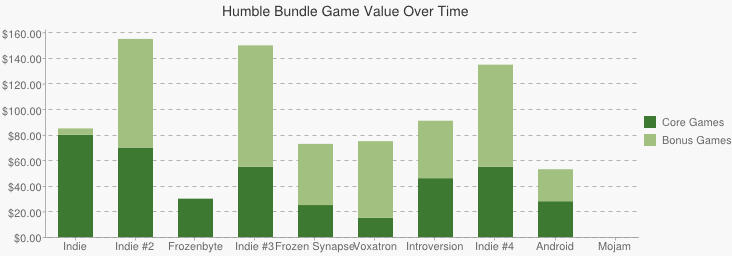
For the purposes of this chart, games that were not included at the time of a bundle's launch or were only available to purchasers who contributed more than the average are considered bonus games. All values have been sourced from developers' online stores where available and Steam where not (with the exception of Canabalt, which is sourced from the iTunes app store. Prices current as at April 11th 2012.
It's worth noting that prices have not been given to tech demos, pre-orders, prototypes or other games that do not have a price ascribed to them or are not available for purchase. In this respect, the Mojam event's monetary value is not indicative of the worth of the three games developed for the event.
The "separate price" value of bonus games included in Humble Bundle promotions seems to outweigh that of core titles. Whilst the number of bonus games included in Humble Bundle promotions have generally outnumbered core titles, less than half of those bonus titles are games that have not previously been included in a bundle. This means that though the combined "separate price" value is high, the "separate price" for the core titles is most relevant to repeat Humble Bundle contributors.
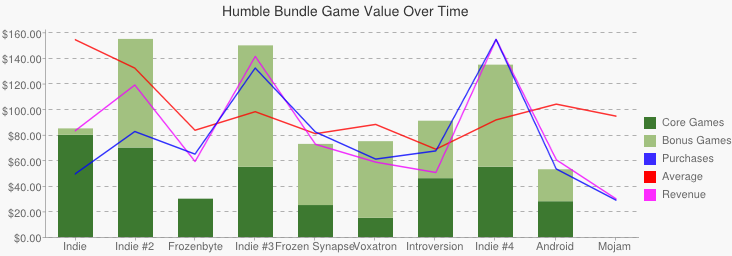
For the purposes of this chart, games that were not included at the time of a bundle's launch or were only available to purchasers who contributed more than the average are considered bonus games. All values have been sourced from developers' online stores where available and Steam where not (with the exception of Canabalt, which is sourced from the iTunes app store. Prices current as at April 11th 2012.
Note that the lines representing purchases, averages and revenue are not to scale.
By overlaying statistics for purchases, averages and revenue, we can see that there is no reliable correlation between "separate price" values for bundles and purchasing patterns. Averages, purchases (and therefore revenue) have distinct peaks for Indie bundles, which generally have more titles and subsequently higher "separate price" values, but the strength of these peaks does not match the variation in "separate price" values. Similarly the Non-Indie bundles do not appear to have any consistent correlations between "separate price" values and other statistics. This seems to point the finger at game content and the other items mentioned above as being the key contributing factors to purchaser behaviour rather than "separate price" values.
Revenue and Frequency
Following the recent Humble Visualisations update which included the timeline chart and table, a reader (DerRidda) suggested that the variations in time between Humble Bundle promotions may be an indicator of a deliberate attempt to find a balance between total revenue and bundle frequency.
| Bundle Title | First Seen | Days since Prev | Revenue per Day of Lead Time | Total Revenue |
|---|---|---|---|---|
| The Humble Indie Bundle | 2010-05-04 | 0 | $0.00 | $1,273,613.80 |
| The Humble Indie Bundle #2 | 2010-12-14 | 224 | $8,155.65 | $1,826,864.51 |
| The Humble Frozenbyte Bundle | 2011-04-12 | 119 | $7,651.22 | $910,495.41 |
| The Humble Indie Bundle #3 | 2011-07-26 | 105 | $20,664.57 | $2,169,779.44 |
| The Humble Frozen Synapse Bundle | 2011-09-28 | 64 | $17,439.59 | $1,116,133.45 |
| The Humble Voxatron Debut | 2011-10-31 | 33 | $27,358.71 | $902,837.35 |
| The Humble Introversion Bundle | 2011-11-22 | 22 | $35,387.04 | $778,514.90 |
| The Humble Indie Bundle #4 | 2011-12-13 | 21 | $113,013.69 | $2,373,287.56 |
| The Humble Bundle for Android | 2012-01-31 | 49 | $18,978.51 | $929,947.19 |
| The Humble Bundle Mojam | 2012-02-17 | 17 | $26,961.12 | $458,338.98 |
This table shows the frequency with which Humble Bundle promotions have occurred alongside the total revenue raised for each.
The red text indicates a Humble Indie Bundle, while blue text represents non-Indie branded bundles.
Please note that day values represent the time between start dates, rather than the gap between end and start.
The table above divides each bundle's revenue by the time between start dates (the only date the Humble Visualisations page currently tracks), showing "per day" impact of lead times on total revenue.
Steady "per day" drops as Humble Bundle frequency increases would suggest that contributors game/charity budget is being significantly stretched, but this is not what we see. Instead, these figures reveal some surprising indicators regarding the performance of Non-Indie bundles such as the Introversion bundle (highest Non-Indie "per day" value, and second shortest Non-Indie lead time), the Voxatron Debut (second highest "per day" value and third shortest Non-Indie lead time) and the Mojam event (third highest Non-Indie per-day value and shortest lead time of any Humble Bundle promotion).
The performance of the Humble Indie Bundle #4 coupled with its comparatively short lead time strongly suggests that in addition to more frequent bundles currently able to support the total revenue figures seen, shorter bundle lead time seems to correspond with increased bundle growth in terms of both revenue and purchasers, which are the most important aspects in a pay-what-you-want model. Whether or not the current trend of bundle schedules is maintainable as the markets approach saturation remains to be seen, but for the moment, these figures portray shorter bundle lead times in a positive light.
On Averages
Whilst providing feedback on the "separate price" visualisations, a reader (meklu) suggested that it might be meaningful to see averages as percentages of "separate price" values.
| Bundle Title | Core Value | Bonus Value | Total Value | Average Payment | % of Total Value |
|---|---|---|---|---|---|
| The Humble Indie Bundle | $79.92 | $5.00 | $84.92 | $9.18 | 10.81% |
| The Humble Indie Bundle #2 | $69.97 | $84.92 | $154.89 | $7.85 | 5.07% |
| The Humble Frozenbyte Bundle | $29.97 | N/A | $29.97 | $4.97 | 16.58% |
| The Humble Indie Bundle #3 | $54.87 | $94.97 | $149.84 | $5.83 | 3.89% |
| The Humble Frozen Synapse Bundle | $24.99 | $47.82 | $72.81 | $4.81 | 6.61% |
| The Humble Voxatron Debut | $15.00 | $59.93 | $74.93 | $5.24 | 6.99% |
| The Humble Introversion Bundle | $46.00 | $44.93 | $90.93 | $4.09 | 4.50% |
| The Humble Indie Bundle #4 | $54.95 | $79.81 | $134.76 | $5.45 | 4.04% |
| The Humble Bundle for Android | $27.98 | $24.99 | $52.97 | $6.18 | 11.67% |
| The Humble Bundle Mojam | N/A | N/A | N/A | $5.62 | N/A |
For the purposes of this table, games that were not included at the time of a bundle's launch or were only available to purchasers who contributed more than the average are considered bonus games. All values have been sourced from developers' online stores where available and Steam where not (with the exception of Canabalt, which is sourced from the iTunes app store. Prices current as at April 11th 2012.
I had also tried requesting some additional statistics from the Humble Bundle guys, but unfortunately they were too snowed under to put together the stuff I was asking for (though the response I received hinted that there is a possibility that these figures might become available in the future). In particular, I'd be very interested to see what the platform averages would look like with contributions below $1.00 and above $500 removed. Though we know from the HIB#1 and HIB#2 slides shown during the Humble Indie Bundle GDC 2011 talk and the top contributors lists across all bundles that payments below $1.00 and above $500 have contributed greatly to the total revenue figures, we have no indication of how payment values are distributed per platform.
A lot of people (including myself to an extent) claim that high Linux averages are indicative of greater enthusiasm on the part of Linux gamers. Many attribute this to a perceived lack of choice for quality games on Linux, others attribute it to purchasing on principle to promote Linux as a viable gaming platform, and others attribute it to an affinity that Linux users might have for charities and causes. Whilst I'm certain that all of these attitudes play some part in defining the Linux average, something has always nagged at me that I hadn't until recently been able to put my finger on.
"Almost all bronies are gamers, but there's also big support for charity. Off the top of my head there have been brony-created projects to support Toys for Tots, Doctors Without Borders, the Children's Cancer Association, and various Your Siblings projects, not to mention all the Humble Indie Bundle charities. I had the hope that creating one movement supporting both charity and indie gaming would strike a chord with bronies, and it turned out better than I could have hoped: the last time I crunched the numbers there were over 1000 donators to the Humble Brony Bundle with an average donation of $16.95, higher than any platform average." - @HumbleBrony
When compared to the "separate price" values for each bundle, the Linux averages do not seem to indicate that Linux users have spare money to throw around due to a lack of choice, and they don't match the kind of zealotry or fanaticism that many attribute the higher averages to. If Linux users truly were specifically aiming to raise the visibility of Linux as a platform and to actively support developers in a way that proved that the Linux market is viable, then Linux user contributions would consistently be above the combined retail prices of titles included in the bundles, and that isn't what the data suggests.
It's my suspicion that the distribution of platform averages is not indicative of Linux users spending more, but of a higher number of Windows and MacOS users contributing less. This may sound like the same thing, but there's a subtle difference. I'm anticipating that without the contributions of less than $1.00 and more than $500, the truncated Windows and MacOS averages would adjust to be more or less equivalent to the current Linux averages. If this is the case, then it would go against some of the most popular industry perceptions of the Humble Bundle promotions and aid better understanding of individual platform purchasing behaviours.
↑return to top↑
A note from Cheese
Thanks for reading, and an extra special thanks to the Humble Bundle contributors who provided quotes (expiredpopsicle, garrynewman, mtgox, nimbledave, notch, tantepose, tpjeff, and humblebrony).
I'd also like to thank Jeffrey Rosen for his time and patience with answering my questions regarding the distinction between Indie and Non-Indie bundles. I've also had some helpful info given by Support Ninja Josh.
When I first began working on this article, the Humble Indie Bundle #4 had just finished, and it was my hope to get it published before the next promotion was launched. At the time of publishing, the Humble Bundle for Android #2 was still running, and I decided to not include it in the interests of avoiding comparing incomplete data with data from expired promotions.
I'm not intending to update this article with reflections on future bundles (even though I did update it to include some additional graphs, quotes and interpretations), but I may consider writing a follow-up once we've seen another ten bundles.
In September 2012, Reclaim Your Game published an interview with me about my analysis. I've also published a short article on the Humble Music Bundle and how it might help interpret the data from game oriented bundles.
If you want to see up to date graphs and statistics for newer bundles, make sure to drop by the Humble Visualisations page.
If you've got any thoughts on this article, you can email me at cheese@twolofbees.com.
This article was published on the 26th of March 2012.